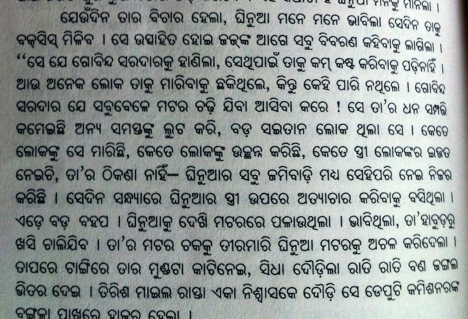Subhas Chandra Pattanayak
BJD member in Orissa Legislative Assembly Debashish Nayak has made a demand in the House that the parked and abandoned Dakota airplane of Biju Patnaik’s Kalinga Airlines be brought from Kolkata airpost and be preserved in the State Museum at Bhubaneswar. Sycophancy knows no bound. But it will be the worst insult to patriotism if his demand is fulfilled.
I explain, why.
A major reason of more than eleven thousand square kilometers of our soil being lost in the Chinese aggression was because of Biju Patnaik’s treachery against the country executed through his Kalinga Airlines.
On October 20, 1962, China had attacked India. We had to suffer the most ignominious defeat in Chinese hands, because there was a man Biju Patnaik in the near circle of Prime Minister Nehru eager to make huge income by sabotaging the country.
Brig. John Delvi in his book ‘Himalayan Blunder’ has pointed out that India lost more than 11000 square kilometers of her land to China in the 1962 war because of lack of basic essentials like warm clothing, snow boots, and glasses.
Biju Patnaik had fetched the contract to airdrop these essential supplies to our soldiers in the NEFA front. But, instead of delivering the same to our soldiers, he had sold away those supplies in black-markets (Lok Sabha Debates (V) (1967) 7980-7990).
Because of this treason, our soldiers had lost their stamina to fight and we were in the worst of debacles after our independence.
This particular debate was generated in the environment of availability of Lt. General B. M. Kaul’s accounts on our war debacle in his book ‘The Untold Story’’.
In this book, General Kaul, who was in command, had attributed the defeat partly to inadequate supply of essential necessities too.
Nehru’s then blue-eyed boy Biju had cultivated the contract for delivering the supply of essential necessities to our fighting soldiers in the NEFA front through his Kalinga Airlines. But, instead of delivering the supply to the soldiers, he had sold them in the black-market at Calcutta, at Dibrugarh, at Jorhat and other places.
In the Lok Sabha debate mentioned above, when Hem Barua had rued over this, S. M. Banerjee had pointed out that when in the snow-clad battlefield on the border our soldiers were in dire need of basic essentials like warm clothing, and some of the countries like West Germany had rushed profuse amount of top quality woolens like blankets, pullovers, shocks and snow-shoes etc for use of our fighting forces, the same never reached them, as the rich people grabbed them for their own comfort through the black-market fed by Kalinga Airways of Biju Patnaik.
Despite having sold the essential defense supplies in the black-market, Biju had bagged Rs. 1, 78, 33, 416.00 from the exchequer towards charges of their delivery in the border (Prime Minister Nehru’s reply to Surendranath Dwivedi in the Lok Sabha on 25 January 1963)
Biju had committed many offenses against the country even before the Chinese attack. One of these offenses was unauthorized use of an aircraft of his company- known to defense intelligence as a plane under contract with their department – on 26 October 1959 in secret service of a group of unidentified persons that had traveled to and fro between Calcutta and Bombay.
Questionable conduct of Biju’s airways, specifically as the defense of the country was involved, was inquired into through a committee headed by Katju. The findings of this Committee were devastating. But, lest Nehru’s fault in relying upon Biju also gets exposed, his government claimed privilege over the report and denied even the MPs to go through it, though the Lok Sabha was fed with a vetted synopsis thereof after a lot of ruckus.
Biju was the first mafia to have entered politics and polluted politics for personal aggrandizement. Nehru had made shameful contributions to this.
So, despite confession that the Katju Committee had found massive irregularities committed by Kalinga airways, the government was not to terminate the contract with him, as a result of which, the defense supplies did not reach the soldiers in the battle field, but fetched profit for Biju from the black-market in places like Calcutta, Dibrugarh and Jorhat.
The then Minister of State (Home)Vidya Charan Shukla had told Atal Behari Vajpayee in reply to his star question bearing No. 785 on 28 June 1962, that the Public Accounts Committee had found many specific illegalities and forgeries, which the Kalinga Airways of Biju Patnaik had committed. By blackmailing Nehru, Biju escaped prosecution.
The Public Accounts Committee of Parliament had found that during the war, Kalinga Airways had at least 1600 unauthorized flights over the war zone. This was a serious offense. The country had neither authorized nor had funded these 1600 flights over the border where the war was going on, in the most sensitive time. As the PAC mentioned of this matter, and it was clear that the government had to investigate into it, the number of these suspicious and unauthorized flights was tampered with and in place of 1600, the figure was projected as 200. When Mr. G. G. Swell queried on who tampered with the figure of the unauthorized flights, Minister Shukla had declared, that the committee investigating into the specific offenses of Kalinga Airlines, would also look into this mischief.
But, Biju escaped, because any action against him could also have brought to limelight the wrongful patronization Nehru had given to him oblivious of harms that was causing to the country.
The whereabouts of Kalinga Airlines was not kept track of. The loss that the nation suffered because of Biju Patnaik’s treachery was not determined. The pilots of the airways without whose collaboration Biju could not have committed the illegalities were never interrogated, when Kalingalines aircrafts crashed one after one, the last reported being a Douglas C-47A on October 17, 1965 with 8 fatalities that had extinguished the entire crew whom the nation should have interrogated to know the truth.
If anything, Biju deserves posthumous punishment for treachery against the country. Why the debates in parliament, exposures in Katju Committee as well as PAC reports were rendered inconsequential should be investigated into by a competent Judicial Commission of Enquiry, as greater interest of the country calls for that.
Therefore, it would be a great insult to Orissa and to the patriotic sense of the people of Orissa, if the sycophantic demand of the BJD member in the State Assembly is heeded to.



